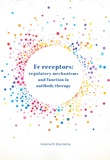Fc receptors
regulatory mechanisms and function in antibody therapy

Brandsma, Arianne
- Promoter:
- Prof.dr J.H.E. (Jürgen) Kuball
- Co-promoter:
- Dr J.H.W. (Jeanette) Leusen
- Research group:
- Kuball
- Date:
- April 19, 2018
- Time:
- 14:30 h
Summary
Fc receptors (FcR) are transmembrane proteins that bind to the Fc tail of antibodies and are widely expressed on leukocytes. Antibody-opsonized pathogens can cross-link FcR, leading to phagocytosis and pathogen killing by phagocytic leukocytes. In the case of antibody-opsonized cells (e.g. virus-infected cells, malignant cells), processes termed antibody-dependent cellular cytotoxicity/phagocytosis (ADCC/ADCP) are triggered. Other cellular processes elicited by the interaction of FcR with antibodies include cytokine release, reactive oxygen species (ROS) production, and antigen presentation. These processes emphasize the central role of FcR in bridging the humoral and cellular responses of the immune system. FcR-mediated effector functions are exploited by therapeutic monoclonal antibodies (mAbs), including those approved for the treatment of cancer. The research described in this thesis focuses on the regulation and activation of Fc receptors and how this can be used in antibody therapy for cancer.
The high affinity receptor for IgG, FcγRI, is saturated with monomeric IgG in vivo, but also after isolation or extravasation of immune cells. Because of this, FcγRI has been far less studied than the low affinity FcγR. However, an important role for FcγRI during inflammation, autoimmune responses, and monoclonal antibody immunotherapy in tumor models has been established. It was demonstrated that FcγRI, saturated with prebound IgG, was capable of effective IC binding after cytokine stimulation. This phenomenon was termed inside-out signaling because ligand binding of the receptor is rapidly enhanced after intracellular signaling without altering its expression levels. Using super-resolution imaging, we found that cytokine stimulation enhanced the clustering of FcγRI in the plasma membrane both before and after immune complex (IC) addition. This increased clustering does not change receptor mobility, but is dependent on an intact actin cytoskeleton and the phosphatase PP1. Furthermore, cytokine-stimulated neutrophils demonstrated a stronger ADCC of CD20-expressing tumor cells. These results indicate a role for cytokine-induced inside-out signaling in altering the nanoscale organization of FcγRI which enhances FcγRI effector functions. FcγRI functions are also regulated by three nonsynonymous single nucleotide polymorphisms (SNPs), since all three SNPs lead to reduced downstream signaling of FcγRI. Although the frequency of these SNPs is low within the population, these SNPs have the potential to alter efficacy of therapeutic mAbs.
Antibody therapy with IgG mAbs is part of the standard treatment of several forms of cancer. IgG mAbs engage FcRs on effector cells to initiate ADCC. However, IgG mAb therapy is rarely curative and this has in part been attributed to exhaustion of cellular effector mechanisms. Co-engagement of activating FcRs with the inhibitory FcRIIb on monocytes or the non-signaling FcRIIIb on neutrophils also limits the cytotoxic activity of IgG mAbs. Engaging FcαRI with IgA anti-tumor mAbs results in more efficient activation of neutrophils compared to IgG and induces different effector functions. In the presence of a heterogeneous population of effector cells (leukocytes), the combination of IgG and IgA anti-tumor mAbs against two different tumor targets (EGFR and HER2) led to enhanced cytotoxicity compared to each isotype alone. Co-injection of cetuximab and IgA2-HER2 resulted in increased anti-tumor effects compared to either mAb alone in a xenograft model with A431-luc2-HER2 cells. Thus, the combination of IgG and IgA isotypes optimally mobilizes cellular effectors for cytotoxicity, representing a promising novel strategy to improve mAb therapy.